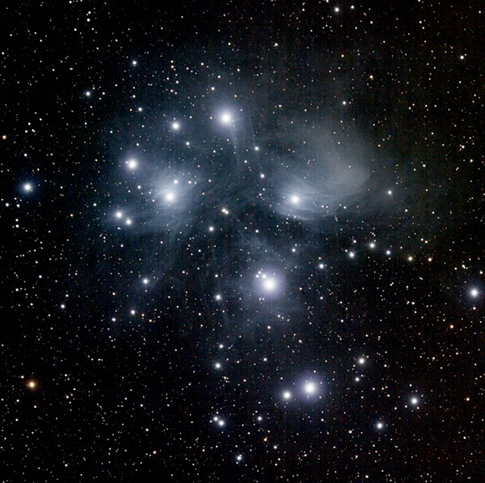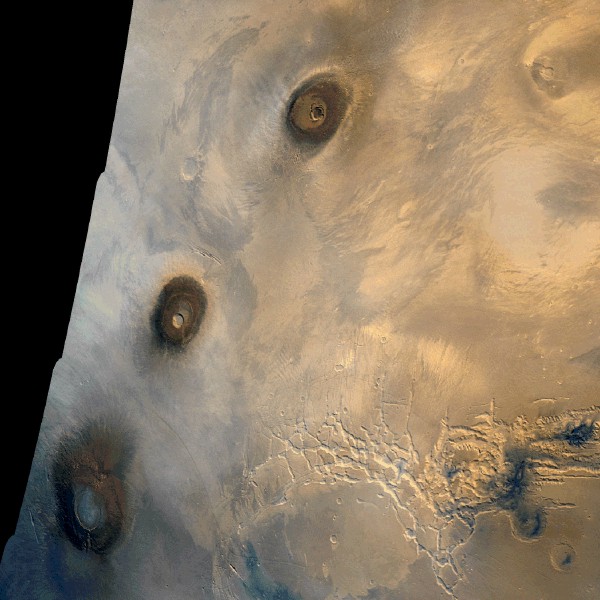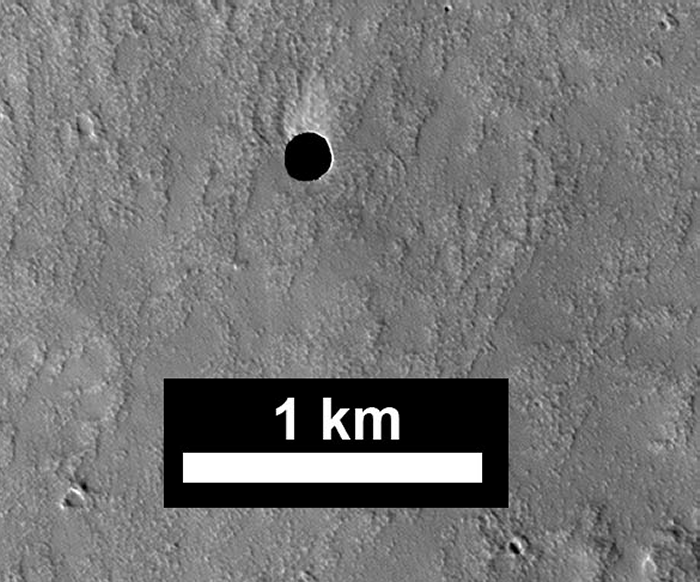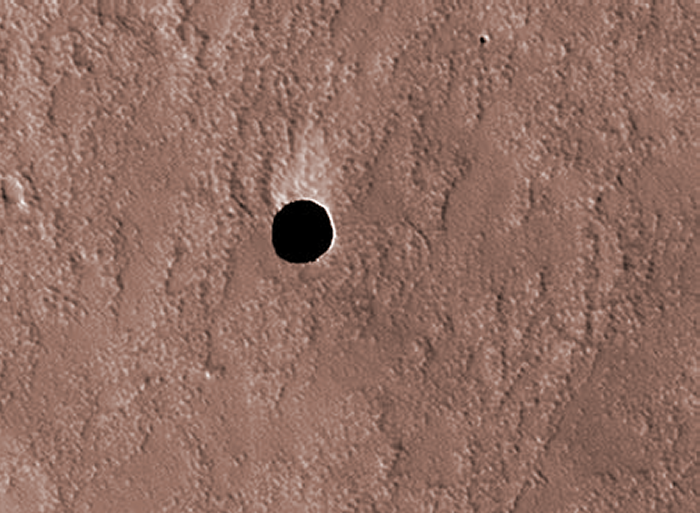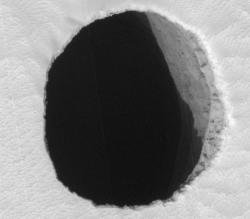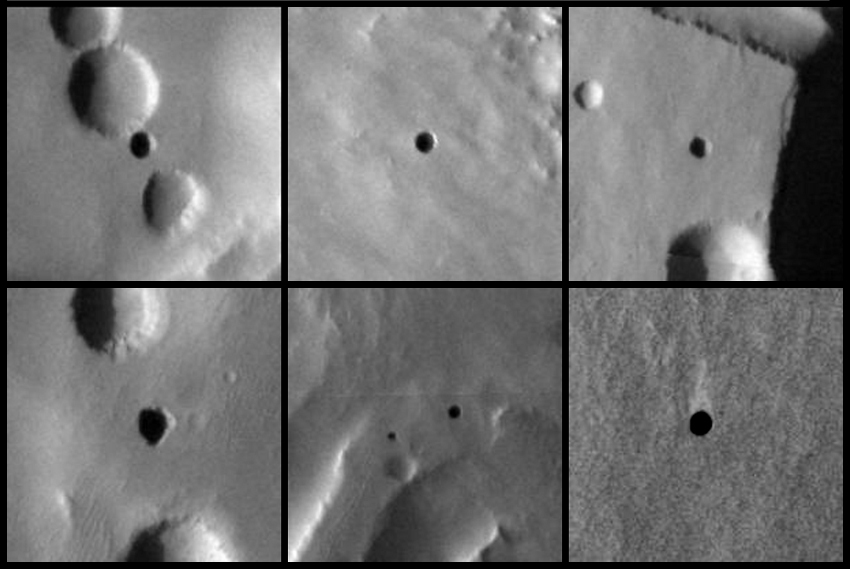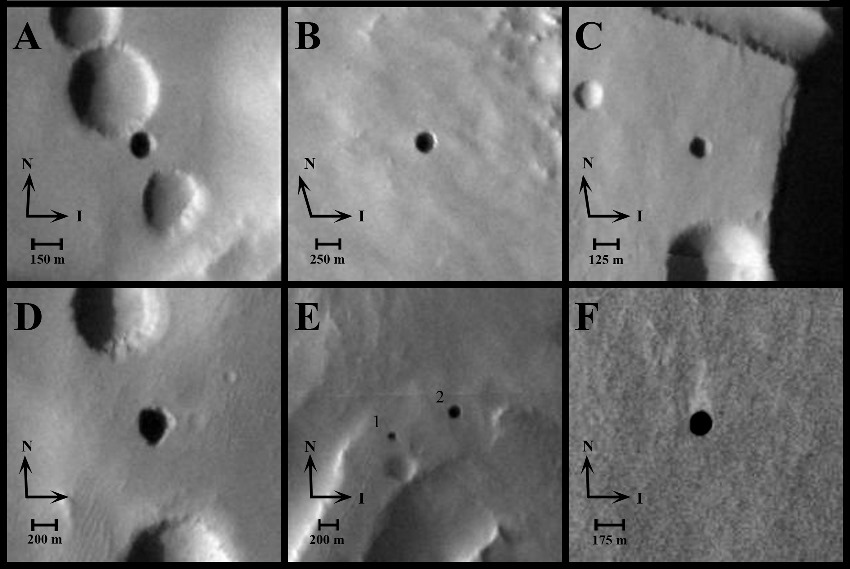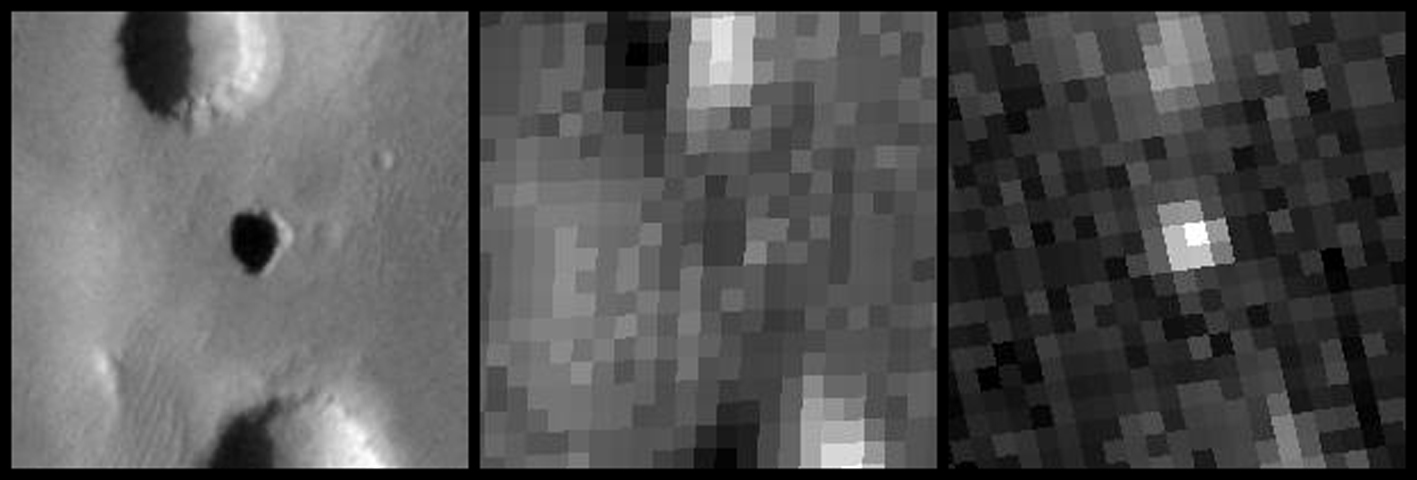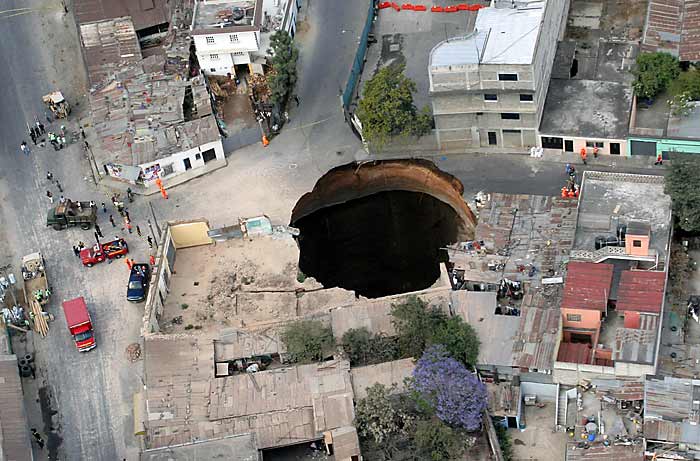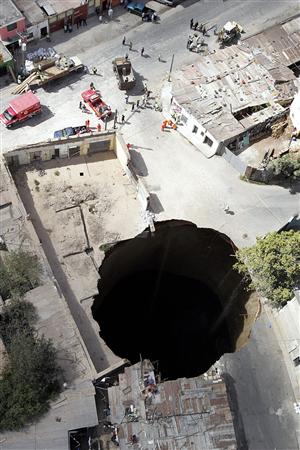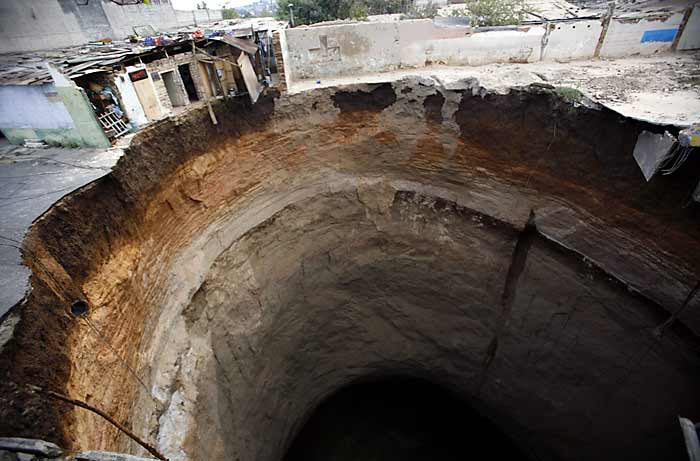|
The Pleiades .
|
||||
|
Agrippa (92 AD) was a Greek astronomer. The only thing that is known about him regards an astronomical observation that he made in 92 AD, which is cited by Ptolemy (Almagest, VII, 3). Ptolemy writes that in the twelfth year of the reign of Domitian, on the seventh day of the Bithynian month Metrous, Agrippa observed the occultation of a part of the Pleiades by the southernmost part of the Moon. |
||||
|
Nickname "The Seven Sisters" |
||||
|
March 17, 2007 .
At left, from top to bottom, are the three 25 km high volcanic shields, Ascraeus Mons, Pavonis Mons and Arsia Mons. 'Cave
entrances' spotted on Mars
Scientists studying pictures from Nasa's Odyssey spacecraft have spotted what they think may be seven caves on the surface of Mars. The candidate caves are on the flanks of the Arsia Mons volcano and are of sufficient depth their floors mostly cannot be seen through the opening. Details were presented here at the Lunar and Planetary Science Conference in Houston, Texas. Temperature data from Mars Odyssey's Themis instrument support the idea. The authors say that the possible discovery of caves on the Red Planet is significant. The caves may be the only natural structures capable of protecting primitive life forms from micrometeoroids, UV radiation, solar flares and high energy particles that bombard the planet's surface. The spacecraft spotted what seemed to be vertical "skylight" entrances to caves below the surface. There is a sheer drop of between about 80m and 130m or more to the cave floors below. 'Seven Sisters' During the day, one of the features
- nicknamed "Annie" - is warmer than surrounding
pits and cooler than sunlit
areas. Night time temperatures are warmer than
nearly all surrounding areas.
"They don't have the rims or sprays of surrounding dust that impact craters have. The data suggest that the holes are at least 80 metres deep,” - Glen Cushing (Nature) The researchers describe the candidate caves as "seven sisters" and have given them all names: Dena, Chloe, Wendy, Annie, Abbey, Nicki and Jeanne. The cave entrances are between 100m and 252m wide (330-828ft). Because in most cases the cave floors cannot be seen, only minimum depths are known: the researchers calculated they must extend between 73m and 96m (240-315ft) below the surface. However, in one image taken of Dena by the Mars Odyssey Camera, a floor can be seen. Using the data, the authors calculated that this cave must extend 130m (426ft) below the surface. Mars Odyssey was launched in April 2001 to hunt for past or present water on the Red Planet. Its Themis (Thermal Emission Imaging System) instrument uses the visible and infrared part of the electromagnetic spectrum to measure the temperature properties of the Martian surface. |
||||
|
May 28, 2007 .
Credit: NASA, JPL, U. Arizona Explanation: Black spots have been discovered on Mars that are so dark that nothing inside can be seen. Quite possibly, the spots are entrances to deep underground caves capable of protecting Martian life, were it to exist. The unusual hole pictured above was found on the slopes of the giant Martian volcano Arsia Mons. The above image was captured three weeks ago by the HiRISE instrument onboard the Mars Reconnaissance Orbiter currently circling Mars. The holes were originally identified on lower resolution images from the Mars Odyssey spacecraft, The above hole is about the size of a football field and is so deep that it is completely unilluminated by the Sun. Such holes and underground caves might be prime targets for future spacecraft, robots, and even the next generation of human interplanetary explorers. Candidate
Cavern Entrance Northeast
of Arsia Mons
Acquisition date: 5 May 2007 This image shows a very dark spot on an otherwise bright dusty lava plain to the northeast of Arsia Mons, one of the four giant Tharsis volcanoes. This is not an impact crater as it lacks a raised rim or ejecta. What's amazing is that we cannot see any detail in the shadow! The cutout shows this dark spot and a version that is "stretched" to best see the darkest area, yet we still cannot see details except noise (1380x782, 1 MB). The HiRISE camera is very sensitive and we can see details in almost any shadow on Mars, but not here. We also cannot see the deep walls of the pit. The best interpretation is that this is a collapse pit into a cavern or at least a pit with overhanging walls. We cannot see the walls because they are either perfectly vertical and extremely dark or, more likely, overhanging. The pit must be very deep to prevent detection of the floor from skylight, which is quite bright on Mars. |
||||
|
(PSP_004847_1745) August 8, 2007 .
Acquisition date: 8 August 2007 Dark pits on some of the Martian volcanoes have been speculated to be entrances into caves. A previous HiRISE image, looking essentially straight down, saw only darkness in this pit. This time the pit was imaged from the west. Since the picture was taken at about 2:30 p.m. local (Mars) time, the sun was also shining from the west. We can now see the eastern wall of the pit catching the sunlight. This confirms that this pit is essentially a vertical shaft cut through the lava flows on the flank of the volcano. Such pits form on similar volcanoes in Hawaii and are called "pit craters." They generally do not connect to long open caverns but are the result of deep underground collapse. From the shadow of the rim cast onto the wall of the pit we can calculate that the pit is at least 78 meters (255 feet) deep. The pit is 150 x 157 meters (492 x 515 feet) across. |
||||
|
September 21, 2007 ..
Seven very dark holes on the north slope of a Martian volcano that have been proposed as possible cave skylights. The discovered holes, dubbed "Seven Sisters." PASADENA, Calif. -- NASA's Mars Odyssey spacecraft has discovered entrances to seven possible caves on the slopes of a Martian volcano. The find is fueling interest in potential underground habitats and sparking searches for caverns elsewhere on the Red Planet. Very dark, nearly circular features ranging in diameter from about 100 to 250 meters (328 to 820 feet) puzzled researchers who found them in images taken by NASA's Mars Odyssey and Mars Global Surveyor orbiters. Using Mars Odyssey's infrared camera to check the daytime and nighttime temperatures of the circles, scientists concluded that they could be windows into underground spaces. Evidence that the holes may be openings to cavernous spaces comes from the temperature differences detected from infrared images taken in the afternoon and in the pre-dawn morning. From day to night, temperatures of the holes change only about one-third as much as the change in temperature of surrounding ground surface. "They are cooler than the surrounding surface in the day and warmer at night," said Glen Cushing of the U.S. Geological Survey's Astrogeology Team and of Northern Arizona University, Flagstaff, Ariz. "Their thermal behavior is not as steady as large caves on Earth that often maintain a fairly constant temperature, but it is consistent with these being deep holes in the ground." A report of the discovery of the possible cave skylights by Cushing and his co-authors was published online recently by the journal Geophysical Research Letters. "Whether these are just deep vertical shafts or openings into spacious caverns, they are entries to the subsurface of Mars," said co-author Tim Titus of the U.S. Geological Survey in Flagstaff. "Somewhere on Mars, caves might provide a protected niche for past or current life, or shelter for humans in the future."
The discovered holes, dubbed "Seven Sisters," are at some of the highest altitudes on the planet, on a volcano named Arsia Mons near Mars' tallest mountain. "These are at such extreme altitude, they are poor candidates either for use as human habitation or for having microbial life," Cushing said. "Even if life has ever existed on Mars, it may not have migrated to this height." The new report proposes that the deep holes on Arsia Mons probably formed as underground stresses around the volcano caused spreading and faults that opened spaces beneath the surface. Some of the holes are in line with strings of bowl-shaped pits where surface material has apparently collapsed to fill the gap created by a linear fault. The observations have prompted researchers using Mars Odyssey and NASA's newer Mars Reconnaissance Orbiter to examine the Seven Sisters. The goal is to find other openings to underground spaces at lower elevations that are more accessible to future missions to Mars. "The key to finding these was looking for temperature anomalies at night -- warm spots," said Phil Christensen of Arizona State University, Tempe, principal investigator for the Thermal Emission Imaging System on Mars Odyssey. That instrument produced both visible-light and infrared images researchers used for examining the possible caves. "No other instrument at Mars could give the thermal information crucial to this research," said the project scientist for Mars Odyssey, Jeffrey Plaut of NASA's Jet Propulsion Laboratory, Pasadena, Calif. "This is a great example of the exciting discoveries Odyssey continues to make." Mars Odyssey reached Mars in 2001, years before any of the other spacecraft currently examining the planet. Its predecessor, Mars Global Surveyor, ended its mission last year. Mars Odyssey
is managed by JPL,
a division of the California Institute of
Technology, Pasadena, for NASA's
Science Mission Directorate, Washington. Lockheed
Martin Space Systems,
Denver, is the prime contractor for the project
and built the spacecraft.
The orbiter's Thermal Emission Imaging System was
developed by Arizona
State University, Tempe, in collaboration with
Raytheon Santa Barbara Remote
Sensing, Santa Barbara, Calif., and is operated by
Arizona State University.
For additional information about Mars Odyssey and
the new findings, visit:
http://www.nasa.gov/mission_pages/odyssey .
Media
contacts: Guy Webster 818-354-6278
Dwayne Brown
202-358-1726
|
||||
|
September 21, 2007 .
3 images
in different wavelengths showing
same patch of Martian ground, centered on a
possible cave called Annie
Image right: Each of the three images in this set
covers the same patch
of Martian ground, centered on a possible cave
skylight informally called
"Annie," which has a diameter about double the
length of a football field.
Seven very dark holes on the north slope of a Martian volcano have been proposed as possible cave skylights, based on day-night temperature patterns suggesting they are openings to subsurface spaces. These six excerpts of images taken in visible-wavelength light by the Thermal Emission Imaging System camera on NASA's Mars Odyssey orbiter show the seven openings. Solar illumination comes from the left in each frame. The volcano is Arsia Mons, at 9 degrees south latitude, 239 degrees east longitude. The features have been given informal names to aid comparative discussion. They range in diameter from about 100 meters (328 feet) to about 225 meters (738 feet). The candidate cave skylights are (A) "Dena," (B) "Chloe," (C) "Wendy," (D) "Annie," (E) "Abby" (left) and "Nikki," and (F) "Jeanne." Arrows signify north and the direction of illumination. Mars Odyssey is managed by NASA's Jet Propulsion Laboratory, a division of the California Institute of Technology, Pasadena, for NASA's Science Mission Directorate, Washington. Lockheed Martin Space Systems, Denver, is the prime contractor for the project and built the spacecraft. The orbiter's Thermal Emission Imaging System was developed by Arizona State University, Tempe, in collaboration with Raytheon Santa Barbara Remote Sensing, Santa Barbara, Calif., and is operated by Arizona State University.
|
||||
|
.
GUATEMALA CITY, Guatemala - A
330-foot-deep sinkhole
killed at least two teenagers as it swallowed about
a dozen homes early
Friday and forced the evacuation of nearly 1,000
people in a crowded Guatemala
City neighborhood. Officials blamed the sinkhole on
recent rains and an
underground sewage flow from a ruptured main.
The pit emitted foul odors, loud noises and tremors, shaking the surrounding ground. A rush of water could be heard from its depths, and authorities feared it could widen or others could open up. |
||||
| FAIR USE NOTICE: This page contains
copyrighted material the use of which has not been
specifically authorized by the copyright owner.
Pegasus Research Consortium distributes this material
without profit to those who have expressed a prior
interest in receiving the included information for
research and educational purposes. We believe this
constitutes a fair use of any such copyrighted
material as provided for in 17 U.S.C § 107. If you
wish to use copyrighted material from this site for
purposes of your own that go beyond fair use, you must
obtain permission from the copyright owner. |
||||
|
~ MENU ~ |
